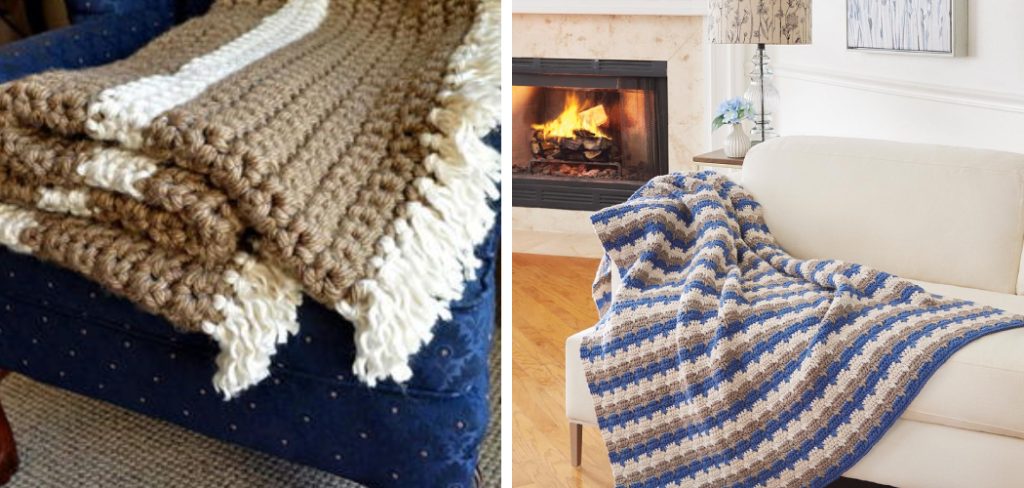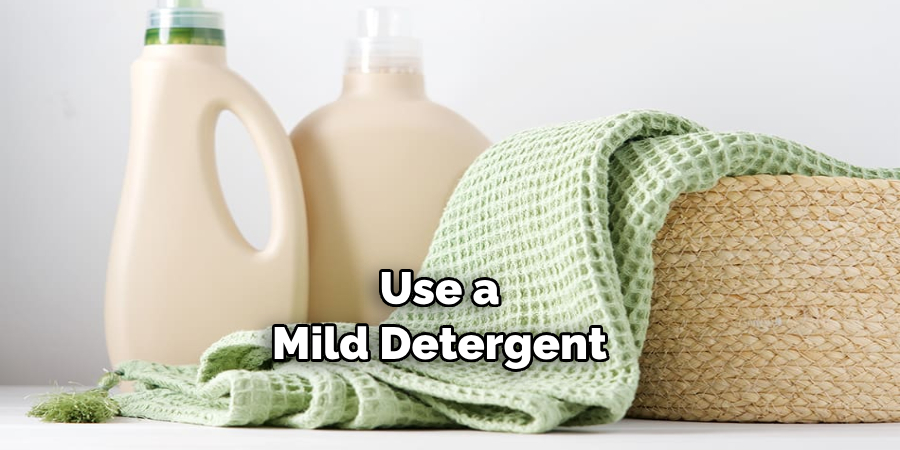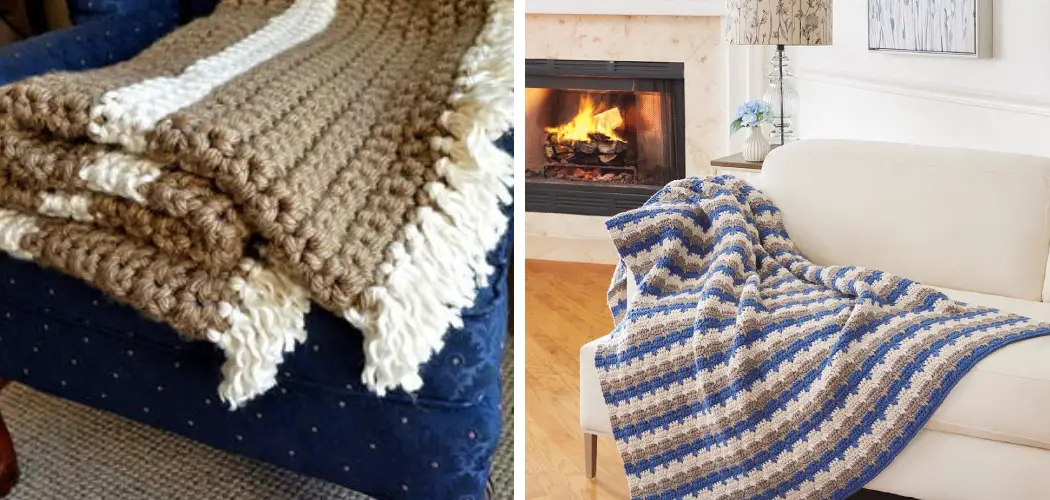Have you ever crocheted a blanket that’s way too stiff? If you’ve ever felt the need to make a cozy crochet blanket but were doubtful of your skills, don’t worry! You’ve probably spent a lot of time, energy, and effort into making the perfect crochet piece only to be disappointed by its stiffness! Don’t worry – we know exactly how hard it can be to make the perfect quilt or Afghan.

But with our helpful tips and tricks on how to soften crochet blanket, your finished project will feel soft, luxurious, and ready for snuggling up with in no time! In this blog post, we’ll guide you through the steps of how to soften your crochet blanket and get it feeling like a much-needed hug from grandma.
So stick around and get ready to learn some pro techniques that will have you cozying up in style in no time! Read on for our step-by-step guide on how to soften your crochet blankets like an absolute pro!
The Necessity of Softening Crochet Blanket
1. To Make It Comfortable
The first step to softening your crochet blanket is understanding why it’s necessary. When you work with different kinds of yarn, the fibers can be very stiff and uncomfortable when used in a blanket. This stiffness is caused by the friction between the different types of fibers used in the weaving process and can also depend on how tight or loose you choose to stitch your blanket.
In order to make your crochet blanket as comfortable as possible, you must soften the fibers of your blanket to make it feel softer and more luxurious. This will also help prevent any snagging or pilling on the surface of your project. Yarns can be made from different types of materials, such as cotton, wool, acrylic, and other synthetic fibers – all of which require different methods for softening.
2. To Make It Last Longer
The second reason why you should soften your crochet blanket is to make it last longer. Unsoftened fibers can cause your project to wear out sooner than expected by breaking down the fibers and causing them to fray.
This can be avoided with a quick and easy softening process that will make your crochet blanket last for years to come. Not to mention, it will also help the fibers retain their shape and color even after washing.
Required Items to Soften Crochet Blanket
Before you start the softening process, it’s important to make sure you have all the necessary items at your disposal. Here is a list of what you will need:
- A bucket or container large enough to hold your blanket
- Warm water
- A mild detergent such as Woolite or Delicate Wash
- A large towel or sheet for drying
- Fabric softener (optional)
Now that you have all the items that you need let’s start the softening process!

How to Soften Crochet Blanket in 10 Steps
Step 1: Fill the Bucket
Fill the bucket or container with warm water. Filling the bucket with lukewarm water is best, as it will help to soften the fibers without causing any damage to the delicate yarn.
Step 2: Add Detergent
Add in a teaspoon of mild detergent such as Woolite or Delicate Wash and stir it into the warm water. This will help to clean your blanket and remove any impurities that may be present.
Step 3: Soak the Blanket
Once the detergent has been stirred into the water, place your crochet blanket into the bucket and let it soak for 15-20 minutes. This will help to soften up the fibers and remove any dirt or oils that may have accumulated on the surface of your project.
Step 4: Rinse the Blanket
After 15-20 minutes, take your blanket out of the bucket and rinse it in cold water. This will help to remove any excess detergent from your crochet piece. Be sure to squeeze the water out gently as you do this.
Step 5: Squeeze Out Excess Water
Once you’ve rinsed the blanket, take it out of the water and squeeze out any excess liquid. Be sure to do this gently so that you don’t stretch or damage the fibers of your project.
Step 6: Wrap in a Large Towel
Take a large towel or sheet and wrap your crochet blanket in it. This will help to absorb any extra moisture from the blanket as it dries. Wrapping the blanket in a towel will also help it to retain its shape.
Step 7: Hang the Blanket
Hang your crochet blanket in a cool, well-ventilated area and leave it to air dry. Make sure that you do not place it near a heat source, as this could cause damage to your project.

Step 8: Tumble Dry
Once the blanket is dry, place it in a gentle cycle in your dryer for about 10-15 minutes. This will help to fluff up and soften the fibers of your crochet piece. Drying the blanket on a low-heat setting is ideal, as this will prevent any damage to your project.
Step 9: Remove and Fold
Once your crochet blanket has finished drying in the dryer, remove it and fold it gently. This will help to keep its shape as well as soften up the fibers of your piece.
Step 10: Add Fabric Softener
If you wish to add an extra layer of softness to your crochet piece, you can add a few drops of fabric softener when you tumble-dry the blanket. This will help to give your project a luxurious feel and make it even softer!
Following these steps will help you soften your crochet blanket and make it feel snug and comfortable. All that’s left to do now is snuggle up in your beautiful creation!
8 Maintenance Tips
Now that you’ve learned how to soften crochet blanket, here are a few tips to help you maintain its luxurious feel and quality:

- Always use a mild detergent when washing your crochet piece. This will help to keep the fibers soft and prevent any damage from harsh chemicals. Otherwise, you could end up with a stiff and uncomfortable blanket.
- Be sure to wash your crochet blanket separately from other items in the washing machine. This will help to preserve its color and shape, as well as to prevent any snags or tangles from forming.
- Avoid using too much fabric softener when washing your crochet piece, as this can cause the fibers to become stiff and uncomfortable. A few drops should do the trick!
- Be sure to hang your blanket in a cool and well-ventilated place to dry. Avoid using direct heat sources such as radiators or dryers, as this could cause damage to your crochet piece.
- If you need to iron your crochet blanket, use the lowest heat setting possible and be sure to press the fabric with a damp cloth. This will help to protect it from any unnecessary damage.
- Always store your crochet piece away from direct sunlight and in a cool, dry place. This will help to preserve its color and make sure that it stays soft for years to come.
- When folding your crochet piece, be sure to fold the fabric along the same lines as when you worked on it. This will help to maintain its shape and keep it looking neat and tidy.
- Periodically check for any snags or tangles in your crochet piece, and use a metal comb to remove them. This will help to keep your blanket looking its best in the long run!
By following these tips, you can be sure that your crochet blanket will stay soft and luxurious for years to come. So go ahead, get snuggling!
Frequently Asked Questions
How Much Will It Cost?
The cost to soften a crochet blanket will depend on the size and type of the blanket, as well as the materials used for softening. Generally, you can expect to spend anywhere from $10-$30 in supplies. Also, some craft stores offer softening services — check with your local store for pricing and availability.

How Long Will It Take?
The amount of time needed to soften a crochet blanket depends on the size and type of the blanket plus the materials used. Generally, it will take between 1-2 hours to complete.
Conclusion
In conclusion, mastering the art of softening a crochet blanket doesn’t have to be overwhelming or time-consuming. Whether you decide to go the traditional washing machine route or venture into alternative methods, there is surely an approach that will work for you.
Don’t be hesitant to experiment with different techniques of how to soften crochet blanket and combine few methods together to get the desired level of softness.
Above all, don’t forget to take necessary precautions before beginning your project and be mindful of caring for your delicate handcraft materials in order to help keep them preserved and presentable for years. Now, take some time to review the basic concepts covered here today and try out these strategies on your next creation. Let us know how it all turns out!

